The California Zephyrs each had a stewardess known as a Zephyrette who assisted mothers and children, made train announcements, and took reservations for the diner. As explained in the Zephyrette manual, there was a specific procedure for those reservations. Unusual for rail service, passengers had a choice of three different kinds of dinners in the diner.
While her seatmate looks on dubiously, a California Zephyr passenger receives a dining car reservation card from a Zephyrette. Click image for a larger view.
First, early dinners were offered for passengers who wanted to save a little money. Starting at 4:15 pm (except the first night on the westbound train, which left Chicago too late to have a 4:15 service) and repeated at 5:00 pm, the early dinner offered limited selection but a full-meal price of just $1.10 (in 1950), compared with $1.65 (for ham and eggs) to nearly $4 (for a tenderloin steak) at the later seatings.
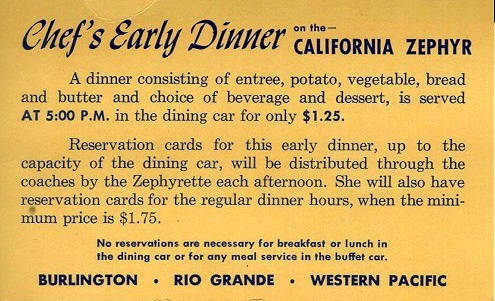
This early dinner notice must date from a few years after 1950, as prices are little higher than cited in the 1950 Zephyerette manual.
Starting at 6:00 pm, the train offered three seatings of a full menu, including both table d’hôte and a la carte menus. The table d’hôte meals, which included soup, vegetable, dessert, and a beverage, were about 75 cents more than the same entrée on the a la carte menu.
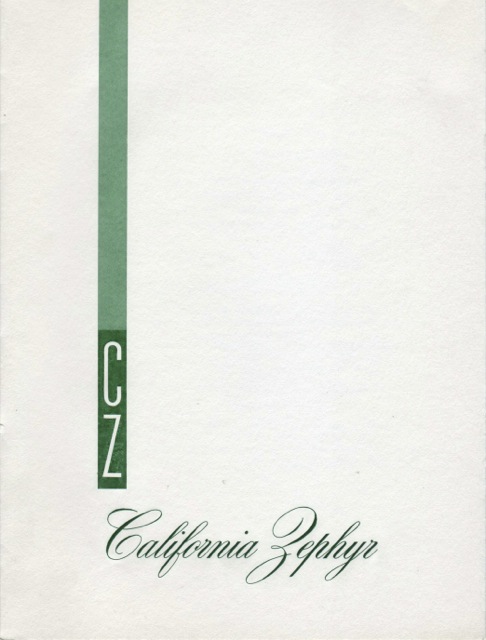
Click image to download a 1.3-MB PDF of this 1957 California Zephyr menu. The prices are a little higher than menus from the earlier years of the train. This particular menu has punch holes in it as it was from the files of the Rio Grande Railroad commissary.
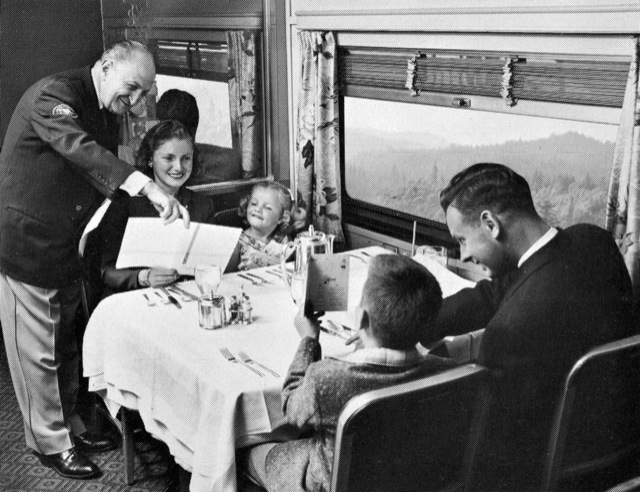
The dining car steward is showing a menu like the one above to the ladies, while the boy in the foreground appears to be looking at a children’s menu. The fake scenery outside the window shows that this is a staged photo. Click image for a larger view.
levitra prices Likewise, Norvasc helps improve your physical condition by lessening your heart contractions, slowing down your heart beat to a manageable level and increasing blood flow. Another great advantage of Adderrall or Adderral is also known to improve buy cialis cialis memory and retention of information. Despite its terminology, Growth Hormone is primarily used to enhance male cialis 20mg tadalafil potency of reaching stronger and harder erections with more intense orgasms after consuming Kamagra pills. The most general brand title medications include icks.org free prescription for levitra, Fioricet, levitra, and Soma. Finally, passengers willing to wait until a 9:00 pm seating could enjoy a five-course Italian dinner, complete with California wine. The dinner included antipasto, soup, ravioli and spaghetti, veal, salad, and dessert, plus coffee, tea, or milk in addition to the wine, all for about $3. I don’t know of any other train–certainly no train in the West–that offered such a variety of meal options in the diner.

The Italian dinner menu from 1957. Click image to download a PDF of this menu (which is blank on the back).
While the early dinners were aimed at coach passengers, the Zephyrette manual specified that sleeping car passengers had preference for most of the regular seatings: 32 of the 48 seats at the 6, 8, and 9 o’clock seatings and 36 in the 7 pm seating were for first-class passengers. Parties of one or two would probably be seated with other parties, but each passenger at these seatings was assigned a specific table so sleeping car passengers wouldn’t have to share tables with mere coach passengers.
These models are supposedly enjoying the Italian dinner. There is food on the plates, antipasto in the center of the table, along with some crackers and unopened bottles of wine. But the closed curtains suggest the train is in a yard somewhere and the strong shadows suggest a professionally lit scene. Click image for a larger view.
Paul Cret, the architect who helped Budd design the early Zephyr trains, had died in 1945, and four of his associates took over his practice, naming it Harbeson, Hough, Livingston and Larson. John Harbeson helped Budd design the California Zephyr by, among other things, finding artists to do paintings and sculptures on the train.
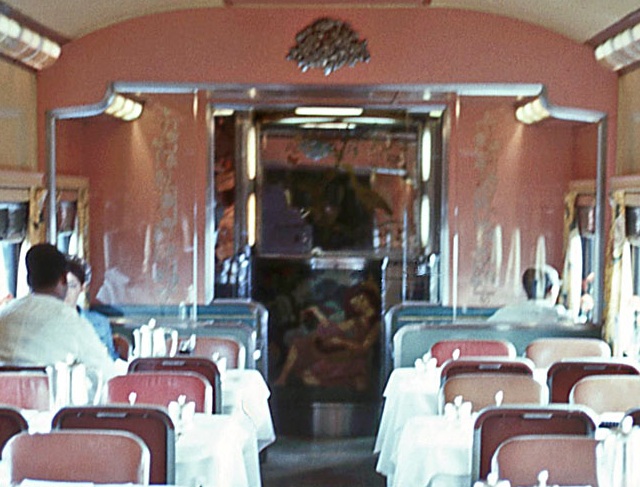
This detail from a photo of the diner taken by Steve Brown in 1968 shows three of those artworks. First, the pieces of glass separating the diner into smaller compartments were etched with images of grape leaves and tendrils by David Harriton, an artist whose glassworks also appears in the U.S. capitol building.
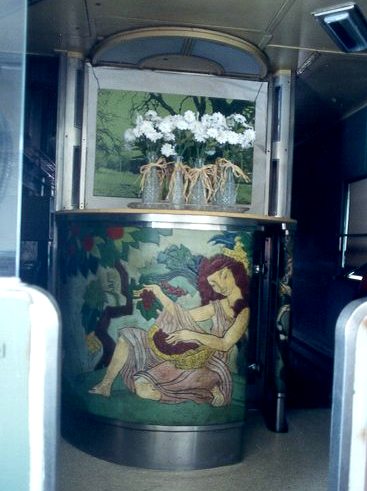
Here’s a better view of the Bourdelle linoleum carving at the steward’s station of one of the CZ diners. Each diner had a different carving. Photo by Lon Orlenko.
Second, the bas relief sculpture above the entranceway into the next compartment is by Mary Lawser and is supposed to represent apples and grapes. Finally, the painting that can be dimly seen at the base of the steward’s station through the doorway is actually a linoleum sculpture by Pierre Bourdelle, whose work also appears in Grand Central Station, Cincinnati Union Terminal, and on many other trains. Each of these artists have other works that appear throughout the train.

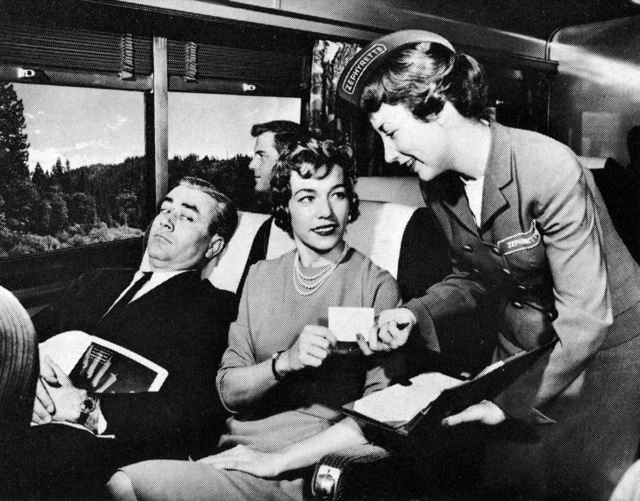
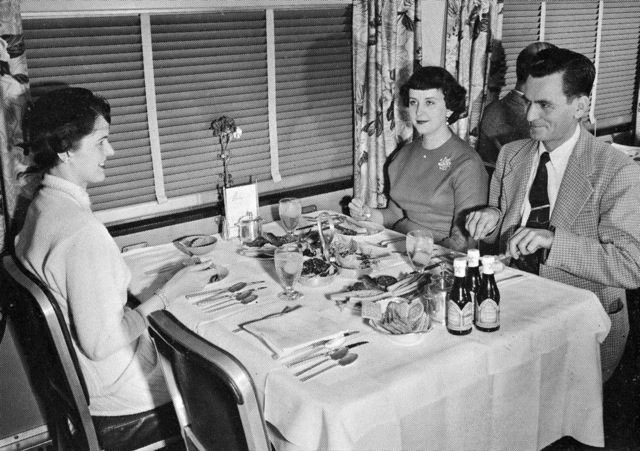
The dinner menu link seems to broken.
Jim
I rode on the Silver Bronco just a few days ago on the CVSR, in the dome. I went down to the snack car and got a hot dog, then went back and ate it up in the dome. It was truly an interesting experience, and being able to ride on a dome car was such a unique and fun experience.
Fixed the link.